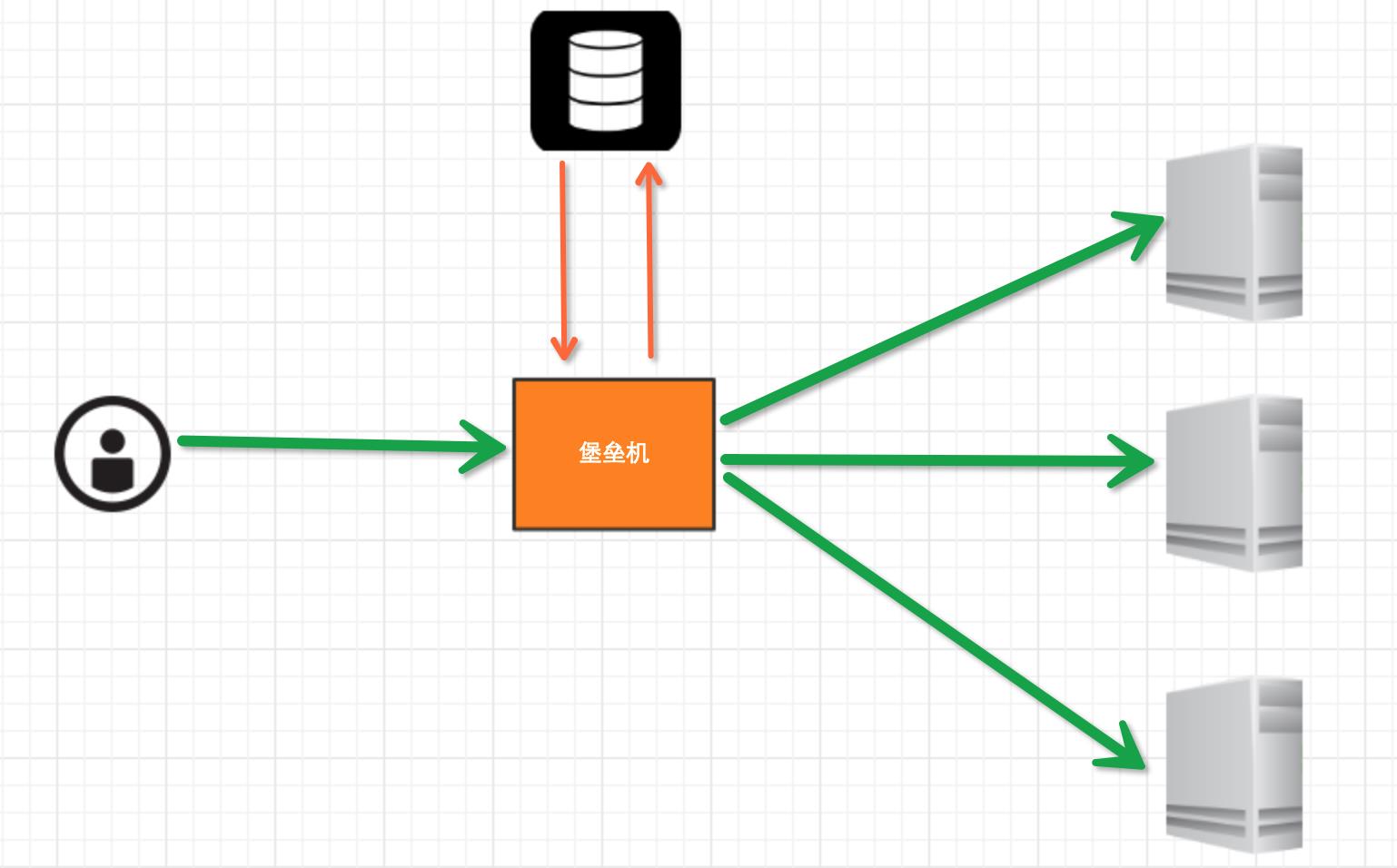堡垒机前戏
开发堡垒机之前,先来学习Python的paramiko模块,该模块机遇SSH用于连接远程服务器并执行相关操作
SSHClient
用于连接远程服务器并执行基本命令
基于用户名密码连接:
|
1
2
3
4
5
6
7
8
9
10
11
12
13
14
15
16
|
import paramiko # 创建SSH对象ssh = paramiko.SSHClient()# 允许连接不在know_hosts文件中的主机ssh.set_missing_host_key_policy(paramiko.AutoAddPolicy())# 连接服务器ssh.connect(hostname=\'c1.salt.com\', port=22, username=\'wupeiqi\', password=\'123\') # 执行命令stdin, stdout, stderr = ssh.exec_command(\'df\')# 获取命令结果result = stdout.read() # 关闭连接ssh.close() |
 SSHClient 封装 Transport
SSHClient 封装 Transport基于公钥密钥连接:
|
1
2
3
4
5
6
7
8
9
10
11
12
13
14
15
16
17
18
|
import paramikoprivate_key = paramiko.RSAKey.from_private_key_file(\'/home/auto/.ssh/id_rsa\')# 创建SSH对象ssh = paramiko.SSHClient()# 允许连接不在know_hosts文件中的主机ssh.set_missing_host_key_policy(paramiko.AutoAddPolicy())# 连接服务器ssh.connect(hostname=\'c1.salt.com\', port=22, username=\'wupeiqi\', key=private_key)# 执行命令stdin, stdout, stderr = ssh.exec_command(\'df\')# 获取命令结果result = stdout.read()# 关闭连接ssh.close() |

import paramiko private_key = paramiko.RSAKey.from_private_key_file(\'/home/auto/.ssh/id_rsa\') transport = paramiko.Transport((\'hostname\', 22)) transport.connect(username=\'wupeiqi\', pkey=private_key) ssh = paramiko.SSHClient() ssh._transport = transport stdin, stdout, stderr = ssh.exec_command(\'df\') transport.close()

import paramiko from io import StringIO key_str = """-----BEGIN RSA PRIVATE KEY----- MIIEpQIBAAKCAQEAq7gLsqYArAFco02/55IgNg0r7NXOtEM3qXpb/dabJ5Uyky/8 NEHhFiQ7deHIRIuTW5Zb0kD6h6EBbVlUMBmwJrC2oSzySLU1w+ZNfH0PE6W6fans H80whhuc/YgP+fjiO+VR/gFcqib8Rll5UfYzf5H8uuOnDeIXGCVgyHQSmt8if1+e 7hn1MVO1Lrm9Fco8ABI7dyv8/ZEwoSfh2C9rGYgA58LT1FkBRkOePbHD43xNfAYC tfLvz6LErMnwdOW4sNMEWWAWv1fsTB35PAm5CazfKzmam9n5IQXhmUNcNvmaZtvP c4f4g59mdsaWNtNaY96UjOfx83Om86gmdkKcnwIDAQABAoIBAQCnDBGFJuv8aA7A ZkBLe+GN815JtOyye7lIS1n2I7En3oImoUWNaJEYwwJ8+LmjxMwDCtAkR0XwbvY+ c+nsKPEtkjb3sAu6I148RmwWsGncSRqUaJrljOypaW9dS+GO4Ujjz3/lw1lrxSUh IqVc0E7kyRW8kP3QCaNBwArYteHreZFFp6XmtKMtXaEA3saJYILxaaXlYkoRi4k8 S2/K8aw3ZMR4tDCOfB4o47JaeiA/e185RK3A+mLn9xTDhTdZqTQpv17/YRPcgmwz zu30fhVXQT/SuI0sO+bzCO4YGoEwoBX718AWhdLJFoFq1B7k2ZEzXTAtjEXQEWm6 01ndU/jhAasdfasdasdfasdfa3eraszxqwefasdfadasdffsFIfAsjQb4HdkmHuC OeJrJOd+CYvdEeqJJNnF6AbHyYHIECkj0Qq1kEfLOEsqzd5nDbtkKBte6M1trbjl HtJ2Yb8w6o/q/6Sbj7wf/cW3LIYEdeVCjScozVcQ9R83ea05J+QOAr4nAoGBAMaq UzLJfLNWZ5Qosmir2oHStFlZpxspax/ln7DlWLW4wPB4YJalSVovF2Buo8hr8X65 lnPiE41M+G0Z7icEXiFyDBFDCtzx0x/RmaBokLathrFtI81UCx4gQPLaSVNMlvQA 539GsubSrO4LpHRNGg/weZ6EqQOXvHvkUkm2bDDJAoGATytFNxen6GtC0ZT3SRQM WYfasdf3xbtuykmnluiofasd2sfmjnljkt7khghmghdasSDFGQfgaFoKfaawoYeH C2XasVUsVviBn8kPSLSVBPX4JUfQmA6h8HsajeVahxN1U9e0nYJ0sYDQFUMTS2t8 RT57+WK/0ONwTWHdu+KnaJECgYEAid/ta8LQC3p82iNAZkpWlGDSD2yb/8rH8NQg 9tjEryFwrbMtfX9qn+8srx06B796U3OjifstjJQNmVI0qNlsJpQK8fPwVxRxbJS/ pMbNICrf3sUa4sZgDOFfkeuSlgACh4cVIozDXlR59Z8Y3CoiW0uObEgvMDIfenAj 98pl3ZkCgYEAj/UCSni0dwX4pnKNPm6LUgiS7QvIgM3H9piyt8aipQuzBi5LUKWw DlQC4Zb73nHgdREtQYYXTu7p27Bl0Gizz1sW2eSgxFU8eTh+ucfVwOXKAXKU5SeI +MbuBfUYQ4if2N/BXn47+/ecf3A4KgB37Le5SbLDddwCNxGlBzbpBa0= -----END RSA PRIVATE KEY-----""" private_key = paramiko.RSAKey(file_obj=StringIO(key_str)) transport = paramiko.Transport((\'10.0.1.40\', 22)) transport.connect(username=\'wupeiqi\', pkey=private_key) ssh = paramiko.SSHClient() ssh._transport = transport stdin, stdout, stderr = ssh.exec_command(\'df\') result = stdout.read() transport.close() print(result)
SFTPClient
用于连接远程服务器并执行上传下载
基于用户名密码上传下载
|
1
2
3
4
5
6
7
8
9
10
11
12
|
import paramikotransport = paramiko.Transport((\'hostname\',22))transport.connect(username=\'wupeiqi\',password=\'123\')sftp = paramiko.SFTPClient.from_transport(transport)# 将location.py 上传至服务器 /tmp/test.pysftp.put(\'/tmp/location.py\', \'/tmp/test.py\')# 将remove_path 下载到本地 local_pathsftp.get(\'remove_path\', \'local_path\')transport.close() |
基于公钥密钥上传下载
|
1
2
3
4
5
6
7
8
9
10
11
12
13
14
|
import paramikoprivate_key = paramiko.RSAKey.from_private_key_file(\'/home/auto/.ssh/id_rsa\')transport = paramiko.Transport((\'hostname\', 22))transport.connect(username=\'wupeiqi\', pkey=private_key )sftp = paramiko.SFTPClient.from_transport(transport)# 将location.py 上传至服务器 /tmp/test.pysftp.put(\'/tmp/location.py\', \'/tmp/test.py\')# 将remove_path 下载到本地 local_pathsftp.get(\'remove_path\', \'local_path\')transport.close() |

#!/usr/bin/env python # -*- coding:utf-8 -*- import paramiko import uuid class Haproxy(object): def __init__(self): self.host = \'172.16.103.191\' self.port = 22 self.username = \'wupeiqi\' self.pwd = \'123\' self.__k = None def create_file(self): file_name = str(uuid.uuid4()) with open(file_name,\'w\') as f: f.write(\'sb\') return file_name def run(self): self.connect() self.upload() self.rename() self.close() def connect(self): transport = paramiko.Transport((self.host,self.port)) transport.connect(username=self.username,password=self.pwd) self.__transport = transport def close(self): self.__transport.close() def upload(self): # 连接,上传 file_name = self.create_file() sftp = paramiko.SFTPClient.from_transport(self.__transport) # 将location.py 上传至服务器 /tmp/test.py sftp.put(file_name, \'/home/wupeiqi/tttttttttttt.py\') def rename(self): ssh = paramiko.SSHClient() ssh._transport = self.__transport # 执行命令 stdin, stdout, stderr = ssh.exec_command(\'mv /home/wupeiqi/tttttttttttt.py /home/wupeiqi/ooooooooo.py\') # 获取命令结果 result = stdout.read() ha = Haproxy() ha.run()
堡垒机的实现
实现思路:

堡垒机执行流程:
- 管理员为用户在服务器上创建账号(将公钥放置服务器,或者使用用户名密码)
- 用户登陆堡垒机,输入堡垒机用户名密码,现实当前用户管理的服务器列表
- 用户选择服务器,并自动登陆
- 执行操作并同时将用户操作记录
注:配置.brashrc实现ssh登陆后自动执行脚本,如:/usr/bin/python /home/wupeiqi/menu.py
实现过程
步骤一,实现用户登陆
|
1
2
3
4
5
6
7
8
|
import getpassuser = raw_input(\'username:\')pwd = getpass.getpass(\'password\')if user == \'alex\' and pwd == \'123\': print \'登陆成功\'else: print \'登陆失败\' |
步骤二,根据用户获取相关服务器列表
|
1
2
3
4
5
6
7
8
9
10
11
12
13
14
15
16
17
18
19
20
21
|
dic = { \'alex\': [ \'172.16.103.189\', \'c10.puppet.com\', \'c11.puppet.com\', ], \'eric\': [ \'c100.puppet.com\', ]}host_list = dic[\'alex\']print \'please select:\'for index, item in enumerate(host_list, 1): print index, iteminp = raw_input(\'your select (No):\')inp = int(inp)hostname = host_list[inp-1]port = 22 |
步骤三,根据用户名、私钥登陆服务器
|
1
2
3
4
5
6
7
8
9
10
11
12
13
14
15
16
17
18
19
20
21
22
|
tran = paramiko.Transport((hostname, port,))tran.start_client()default_path = os.path.join(os.environ[\'HOME\'], \'.ssh\', \'id_rsa\')key = paramiko.RSAKey.from_private_key_file(default_path)tran.auth_publickey(\'wupeiqi\', key)# 打开一个通道chan = tran.open_session()# 获取一个终端chan.get_pty()# 激活器chan.invoke_shell()########## 利用sys.stdin,肆意妄为执行操作# 用户在终端输入内容,并将内容发送至远程服务器# 远程服务器执行命令,并将结果返回# 用户终端显示内容#########chan.close()tran.close() |

while True: # 监视用户输入和服务器返回数据 # sys.stdin 处理用户输入 # chan 是之前创建的通道,用于接收服务器返回信息 readable, writeable, error = select.select([chan, sys.stdin, ],[],[],1) if chan in readable: try: x = chan.recv(1024) if len(x) == 0: print \'\\r\\n*** EOF\\r\\n\', break sys.stdout.write(x) sys.stdout.flush() except socket.timeout: pass if sys.stdin in readable: inp = sys.stdin.readline() chan.sendall(inp)

# 获取原tty属性 oldtty = termios.tcgetattr(sys.stdin) try: # 为tty设置新属性 # 默认当前tty设备属性: # 输入一行回车,执行 # CTRL+C 进程退出,遇到特殊字符,特殊处理。 # 这是为原始模式,不认识所有特殊符号 # 放置特殊字符应用在当前终端,如此设置,将所有的用户输入均发送到远程服务器 tty.setraw(sys.stdin.fileno()) chan.settimeout(0.0) while True: # 监视 用户输入 和 远程服务器返回数据(socket) # 阻塞,直到句柄可读 r, w, e = select.select([chan, sys.stdin], [], [], 1) if chan in r: try: x = chan.recv(1024) if len(x) == 0: print \'\\r\\n*** EOF\\r\\n\', break sys.stdout.write(x) sys.stdout.flush() except socket.timeout: pass if sys.stdin in r: x = sys.stdin.read(1) if len(x) == 0: break chan.send(x) finally: # 重新设置终端属性 termios.tcsetattr(sys.stdin, termios.TCSADRAIN, oldtty)

def windows_shell(chan): import threading sys.stdout.write("Line-buffered terminal emulation. Press F6 or ^Z to send EOF.\\r\\n\\r\\n") def writeall(sock): while True: data = sock.recv(256) if not data: sys.stdout.write(\'\\r\\n*** EOF ***\\r\\n\\r\\n\') sys.stdout.flush() break sys.stdout.write(data) sys.stdout.flush() writer = threading.Thread(target=writeall, args=(chan,)) writer.start() try: while True: d = sys.stdin.read(1) if not d: break chan.send(d) except EOFError: # user hit ^Z or F6 pass
注:密码验证 t.auth_password(username, pw)
详见:paramiko源码demo
数据库操作
Python 操作 mysql 模块的安装
|
1
2
3
4
5
|
linux: yum install MySQL-pythonwindow: http://files.cnblogs.com/files/wupeiqi/py-mysql-win.zip |
SQL基本使用
1、数据库操作
|
1
2
3
|
show databases; use [databasename];create database [name]; |
2、数据表操作
|
1
2
3
4
5
6
7
8
9
10
|
show tables;create table students ( id int not null auto_increment primary key, name char(8) not null, sex char(4) not null, age tinyint unsigned not null, tel char(13) null default "-" ); |
 View Code
View Code3、数据操作
|
1
2
3
4
5
6
7
|
insert into students(name,sex,age,tel) values(\'alex\',\'man\',18,\'151515151\')delete from students where id =2;update students set name = \'sb\' where id =1;select * from students |
4、其他
|
1
2
3
|
主键外键左右连接 |
Python MySQL API
一、插入数据
|
1
2
3
4
5
6
7
8
9
10
11
12
13
14
15
|
import MySQLdb conn = MySQLdb.connect(host=\'127.0.0.1\',user=\'root\',passwd=\'1234\',db=\'mydb\') cur = conn.cursor() reCount = cur.execute(\'insert into UserInfo(Name,Address) values(%s,%s)\',(\'alex\',\'usa\'))# reCount = cur.execute(\'insert into UserInfo(Name,Address) values(%(id)s, %(name)s)\',{\'id\':12345,\'name\':\'wupeiqi\'}) conn.commit() cur.close()conn.close() 以上是关于MySQLdb操作数据库的主要内容,如果未能解决你的问题,请参考以下文章
|

